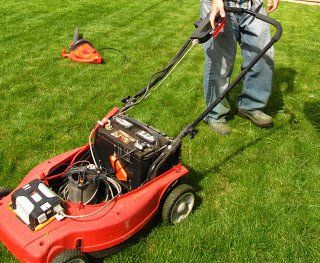Last updated Sunday January 5, 2014
NPS has got to be one of my favorite places to find deals. Any store that sells nuts and bolts by weight is alright in my book. The other day, I happened across a bunch of small 6-volt rechargeable AGM batteries. Most of them were priced at $1.08 each. I have walked by this isle many times before but for some reason, today, I got an epiphany!
“Why not buy 20 of these little guys and string them all together into a 120 volt battery pack?”
Not only would it be a useful test bed for repairing the controller in my electric truck, but I could also modify my electric lawn mower to run on this battery pack instead of the heavy 12 volt deep cycle battery it currently uses.

My electric lawn mower runs great, but it is really heavy and a huge workout pushing it around my ½ acre yard each week. It has a large 115 Amp-Hour, 12 volt battery that powers an inverter, that converts the 12 volt DC up to 120 volts AC, which is then rectified to high voltage DC, which then powers a DC motor. Each conversion has some efficiency loss.
In order to provide enough power to cut a thick green lawn, the 12 Volt battery has to be able to deliver 80 Amps continuously. There is a phenomenon in all batteries called “The Peukert effect” which causes a large battery delivering a lot of amps to act like a lower capacity battery.
For example, If you have a 100 Amp-hour battery, it will provide 1 amp continuously for 100 hours. But if that same battery tried to deliver 100 amps for 1 hour, it wouldn't last for 1 hour like we had hoped. Because of the Peukert effect, it may only last 40 minutes or so depending on the battery chemistry and age of the battery. CURSE YOU PEUKERT EFFECT!!!
A power inverter is a marvelous invention that converts 12 volts DC to 120 volts AC. Like everything else in the universe, work comes at a price. The inverter used on my lawn mower has about a 5-15% efficiency loss involved in the conversion. When the battery is ½ discharged, and while under load, the voltage drops below 10.5 volts and the inverter goes into a low voltage alarm state, shutting itself down. I can still have enough capacity to mow my lawn using this battery, but it bothers me that I am pushing around an extra 20 lbs of lead with no way of extracting the energy out of it.
In addition to the small losses of the bridge rectifier, at 157 Volts, the rectified DC doesn't run the motor at it's top speed either.
By using a 120 Volt DC battery pack, the current draw from the battery will be in the 2 to 5 Amp range, not 60-90 Amps like with a 12 volt battery. Also, because the 120 Volt DC is true DC, and not rectified, unfiltered DC, the motor will run at its full speed.
When the pack starts to discharge, instead of shutting off completely, the motor just spins a little bit slower.
In the last section, I discussed how reducing resistive losses in the battery-inverter wiring allowed an extra 15 minutes of run-time before the inverter would shut down. That worked great but it's time I take it a step further.

Before:
12 Volt 115 Amp-Hour deep-cycle battery = 50.2 lbs (plus inverter and wire 3.4 lbs).
12 X 115 = 1380 Watt-hours, or about 13 cents worth of electricity.
After:
Twenty 6 Volt 4.5 Amp-Hour AGM batteries. 32.4 lbs.
20 X 6 X 4.5 = 540 Watt-hours, or about 5 cents worth of electricity.

Both designs mow the lawn just fine, but for a manually propelled lawn mower, the 21.2 pound weight loss is a night and day difference. By pushing around less weight, it takes me less time to mow my lawn. 1 hour 5 minutes down to ~52 minutes.
